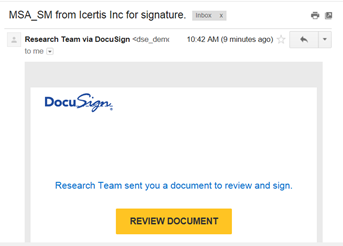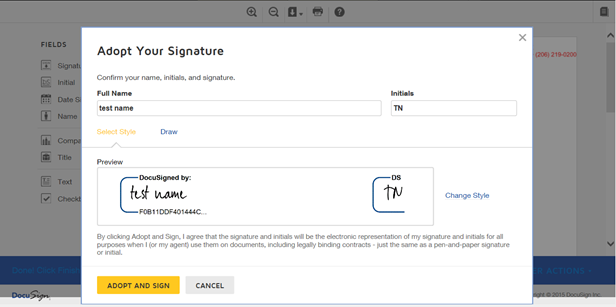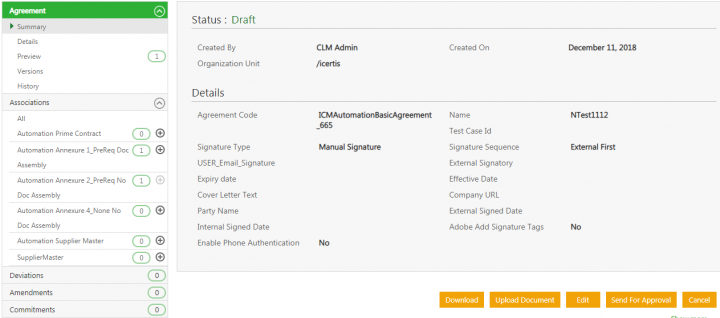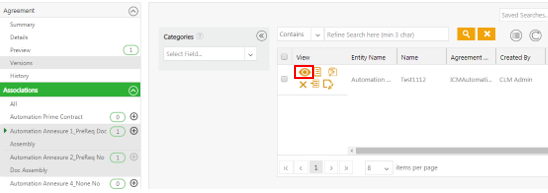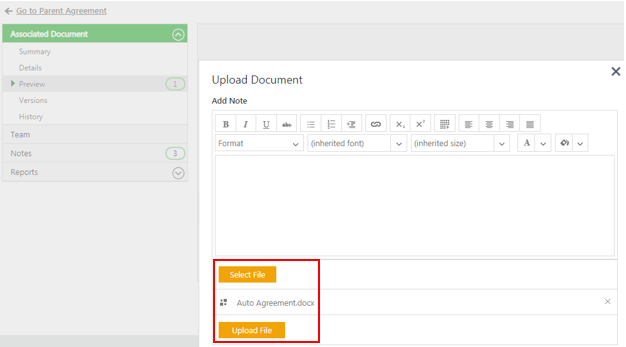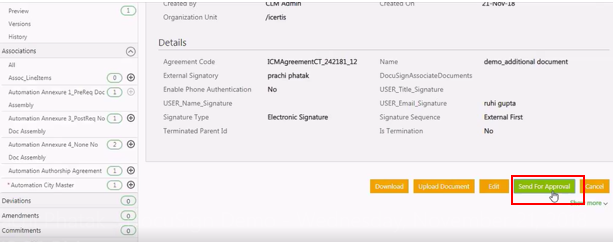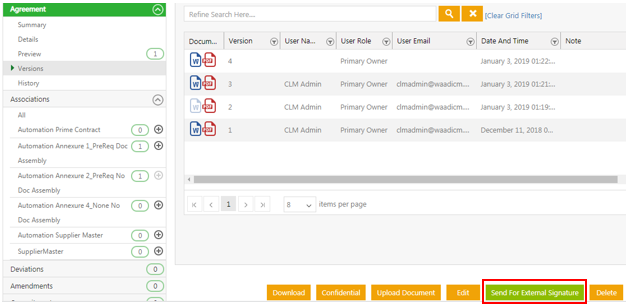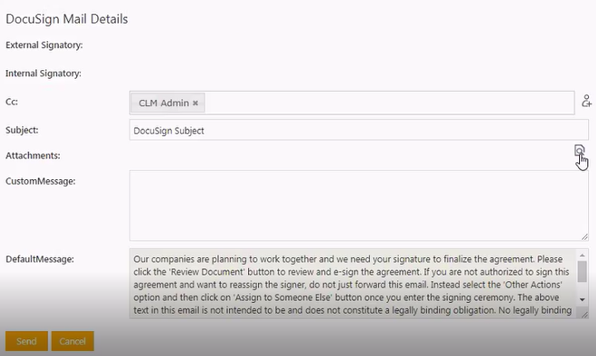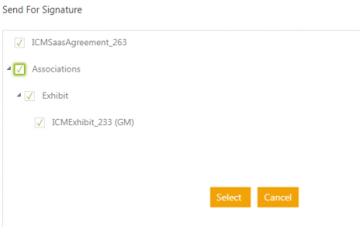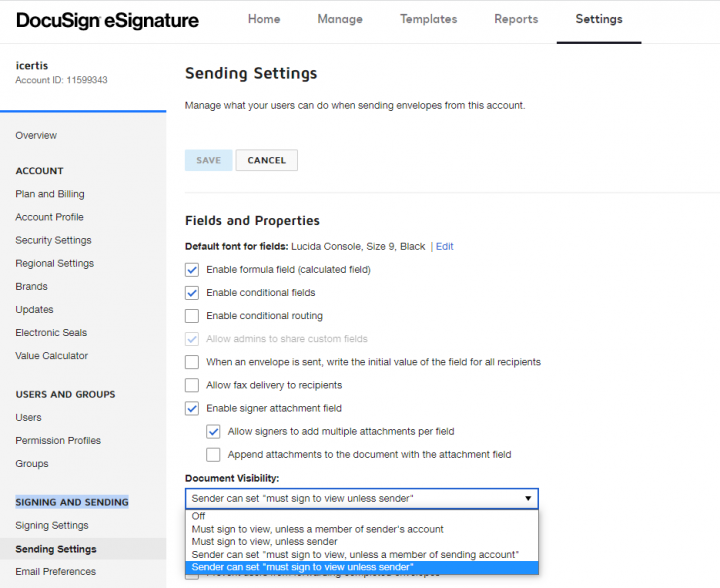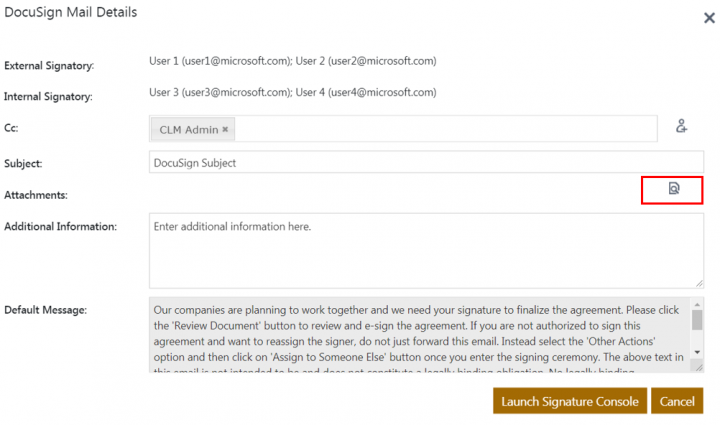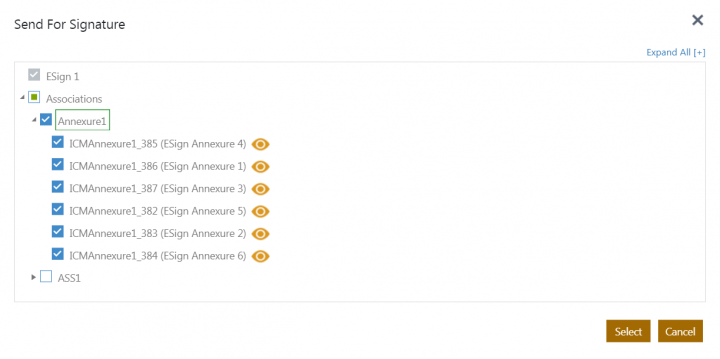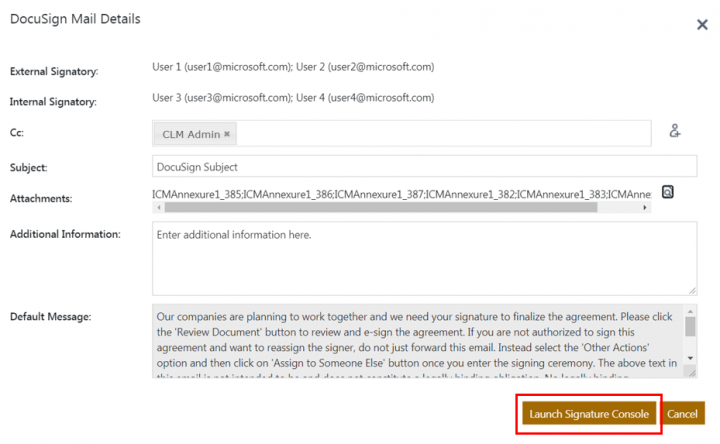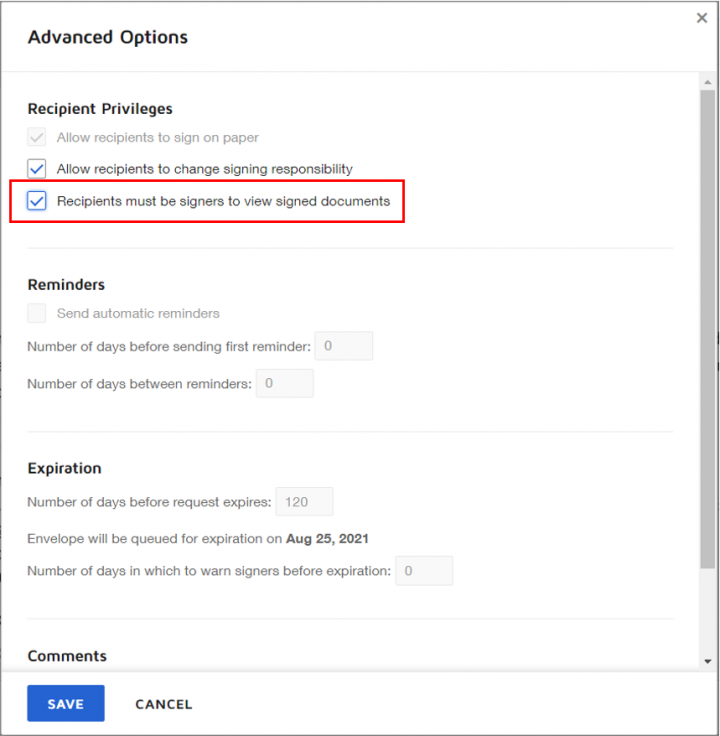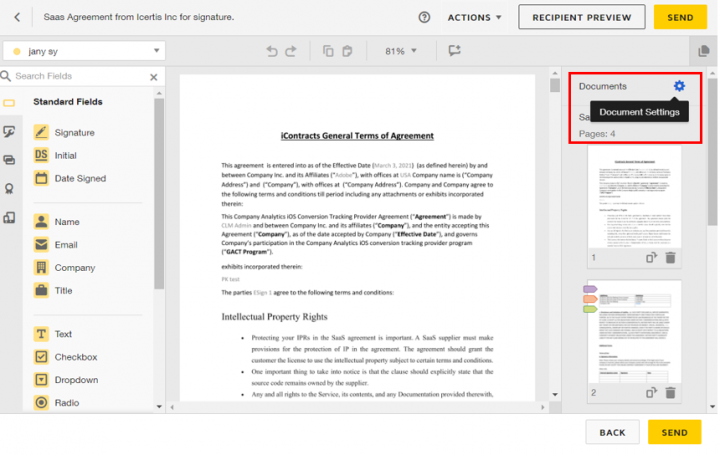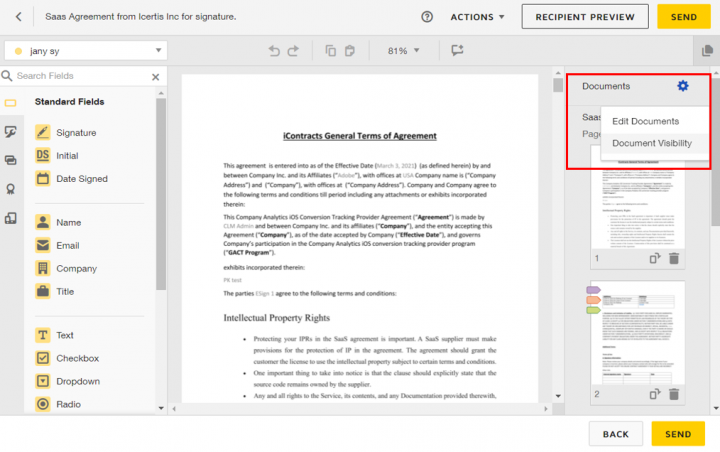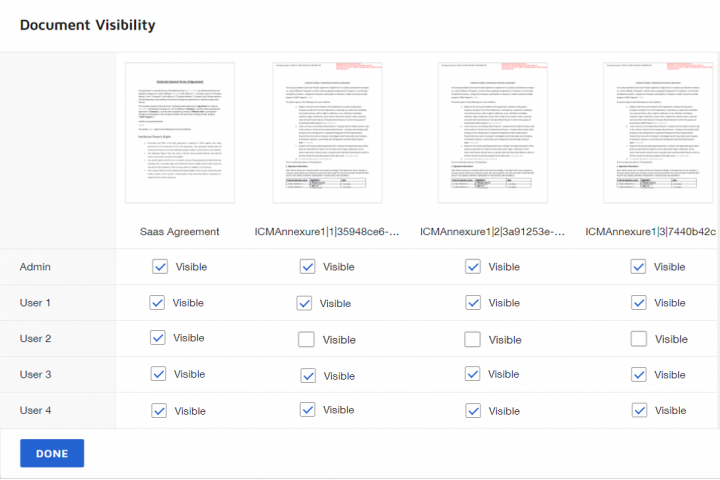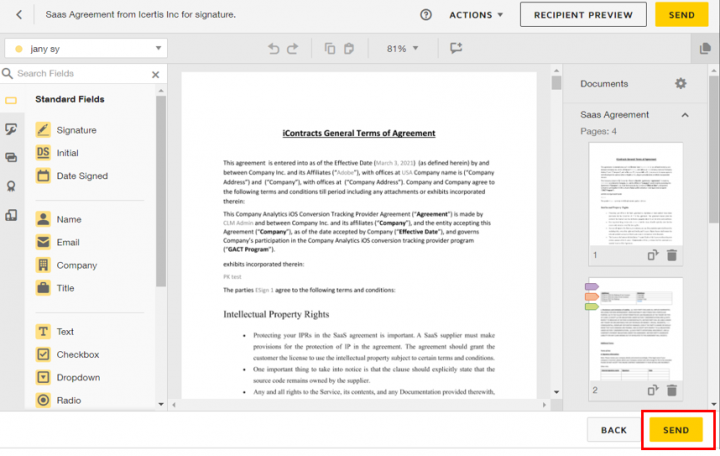Contents
- 1 Using DocuSign
- 1.1 Sending an Own Paper Agreement for Electronic Signature
- 1.2 Electronic Signature for Third Party Paper
- 1.3 Sending Associated documents for Signatures along with the main Agreement
- 1.4 Appending the DocuSign Certificate of Completion in the Executed Agreements
- 1.5 Sending an Agreement for Parallel Signatures using DocuSign
- 1.6 Enabling document visibility
Using DocuSign
Sending an Own Paper Agreement for Electronic Signature
Electronic signatures are done through Docu'Sign (or DocuSign). External signatories can choose one of these applications if they wish to do electronic signatures.
To sign an Agreement electronically:
1. Open the e-mail you receive from DocuSign (or Adobe Sign).
2. Click Review Document. The Please review & Act on These Documents window opens.
3. Select the I agree...check box and click Continue.This enables the Fields menu in the left panel.
4. Click Sign next to Signature. The Adopt Your Signature window is displayed if you are signing the document for the first time.
Note: If you have signed before, the system inserts the signature that you used when you signed for the first time.
5. Verify your Full Name, Initials, and Signature. Your Full Name and Initials appear as they are entered at the time of your user creation process.
Note: You cannot change the signature style once it appears on the document.
6. Click Finish. You receive a notification stating your signature process is completed. The status of the agreement changes to Waiting For Internal Signature. An e-mail is sent to the internal signatory.
Note: Internal Signatory can follow steps 1 to 9 to sign the Agreement electronically. Once signed, the status of the Agreement changes to Executed. A notification email is sent to the Primary Owner, Internal Signatory and External Signatory.
7. Verify your signature on the Select Style tab:
- Click Change Style to change the style of your signature and initials. This displays a list of alternate styles. Use scroll arrows to scroll through the signatures. Select from the list of styles.
- Alternatively, click the Draw tab to draw your own signature. Click Clear to clear the signature.
8. Click Adopt And Sign. The Signature and Initials appear on the document.
All Executed Agreements signed using Adobe Sign, include an audit log of key details in the signature flow, such as:
- The specific actions performed, such a document created, emailed, viewed and electronically signed
- Name of the user that performed these actions
- Time stamp of when those actions were completed
- IP address of the user that completed the actions
This feature is disabled by default and can be enabled from the Global Account Settings of DocuSign.
Electronic Signature for Third Party Paper
Electronic signatures are done through DocuSign or (Adobe Sign). External signatories can choose one of these applications if they wish to do electronic signatures.
To sign an Agreement electronically:
1. Open the e-mail you receive from DocuSign (or Adobe Sign).
2. Click Review Document. This opens the Please review & Act on These Documents window.
3. Select the I agree...checkbox and click Continue. This enables the Fields menu in the left panel.
In the Fields menu, you can use the following options:
- Signature: Drag and drop your signature onto the document.
- Initial: Drag and drop your initials onto the document.
- Date Signed: Drag and drop the Date onto the document. Displays current date by default.
- Name: Drag and drop the Name box. Type your name into the box.
- Company: Drag and drop the Company box. Type the name of your company into the box.
- Title: Drag and drop the Title box. Type the title into the box.
- Text: Drag and drop Text box. Type additional text into the box.
- Checkbox: Drag and drop Checkbox into the document.
4. Drag the Signature onto the document. This opens the Adopt Your Signature window. Verify you full name, initials and signature. Your full name and signature appear as they were entered.
5. Verify your signature on the Select Style tab:
- Click Change Style to change the style of your signature and initials. This shows a list of alternate styles. Use the arrows to scroll through the signatures and select from the list of styles.
- Alternatively, click Draw tab to draw your own signature. ClickClear to clear the signature.
6. Click Adopt And Sign. The signature and initials appear on the document.
7. Click theOther Actions menu.
8. Select from the following options in the window that appears:
- Click FINISH LATER to save the document in its current state and finish the signing process at a later time.
- Click PRINT & SIGN to print the document and sign it in ink. After signing it, scan and upload or fax the document.
- Click ASSIGN TO SOMEONE ELSE to assign a third person as a signatory.
9. In the Assign to Someone Else window:
- Email Address for the New Signer: type the email address of the person you want to assign the envelope.
- New Signer's Name: type the name of the new signor.
Please provide a reason to Research Team for changing signing responsibility: type the reason for changing the signing responsibility.
10. Click ASSIGN TO SOMEONE ELSE. The new signatory and the original sender receive a notification with you in the Cc.
11. Click DECLINE TO SIGN to notify the sender that you refuse to sign the document and put in the reason for declining it in the Comment box. The comments can be seen under Notes on the Agreement Details Page.
12. Click FINISH to complete the signature process. You will receive a notification stating that your signature process is completed. The status of the agreement changes to Waiting For Internal Signature. An email is sent to the internal signatory.
Sending Associated documents for Signatures along with the main Agreement
ICI allows the Primary Owner to select and attach individual copies of the Associated documents along with the main Agreement and send them for signatures via DocuSign, after adding the signatory tags. The Signatories can not only view but also sign these Associated Documents. Thus, the signatory can have all the information required to sign the Agreement at once, so that they do not need to download each of the associated documents separately to find the required information.
Note: DocuSign supports only .pdf and .docx format.
This feature is also supported by Adobe Sign. The file formats supported in Adobe Sign are: .pdf, .docx, .jpeg and .png.
To select and share Associated documents with the Agreement for e-signature using DocuSign:
1. Ensure that you have a script type of Attribute DocuSignAssociatedDocuments in the Contract Type.
2. Open the Agreement with the Associations to be sent for signature using DocuSign.
3. Click the View Document icon to preview the Association.
4. Click Preview to view the associations to verify the ones that you want to send. Only Associations which are in the .pdf and .docx format can be previewed. If you try to preview a document in any other format (for example, XLSX), then a message will be displayed that the format is not supported.
5. Click the Upload Document button.
6. Click Select File in theUpload Document window to upload a file to the association.
7. Click the Send For Approval button to send the Agreement for approval.
8. Click the Send for External Signature button to send the Agreement with associated documents for e-signatures using DocuSign. The DocuSign Mail Details window opens. This option is available only if the DocuSign Associated Document attribute is configured at the Agreement Contract Type level.
10. Fill in the necessary details. Click the Attachment icon. The Send For signature window opens. This displays Association instances for Parent as well as peer association that contain the DocuSign Associate Documents script attribute.
11. Select the required associations from the list. The Signatories defined for the Main Agreement are applicable for its Associated Documents too. Signatories can sign the Parent-Child type of Associations along with the main Agreement Document . If signature tags are not present in any of the Parent-Child Association, then signing is not mandatory.
After signing, Version and History of only the signed Parent Child Association and main Agreement is uploaded and generated with name of the last signatory.
The tags for Peer Association don't get render and the version doesn’t get synched back. Status of Parent Child Association does not change irrespective of the action taken by signatories. After the agreement is executed, only the signed copy of the Agreement gets uploaded.
Appending the DocuSign Certificate of Completion in the Executed Agreements
DocuSign creates a Certificate of Completion at the completion of the signature process. Users can obtain this certificate from the DocuSign portal. It provides details of each signatory on the agreement document, including the signatory IP address, signatory image, key event timestamps, and so on. It helps users to resolve objections that customers may have regarding transaction rejections.
ICI allows users to append the DocuSign Certificate of Completion to the final executed agreement, so that it could be retained for the lifecycle of the contract. This is achieved by a technical configuration which when enabled, the Certificate of Completion will be appended to the final executed PDF agreement and synced back to ICI. By default, the setting is disabled.
DocuSign Limitation:
While attaching the Certificate of Completion to the main agreement, all the associated documents get attached to the main agreement within the DocuSign envelope. Hence, when using the Certificate of Completion and Document Bundling features in a single implementation, the associated documents will also be appended to the main agreement document file from DocuSign.
Sending an Agreement for Parallel Signatures using DocuSign
You can send Agreements for parallel signatures across internal and external signatories, instead of sequentially based on step numbers, when using DocuSign. This can be configured in Rules for signatories allowing ICI users to send the Agreement to either multiple external or internal signatories so that each of them can sign in parallel.
Let’s consider an example of 2 Internal signatories A and B and both are required to sign the Agreement in parallel; then the configurator configures the Approval Rule for internal signatories A and B with the same Step number but different Signatory order.
- So, if signatory A is set at Step Number 10 and Signatory Order 1, but Signatory B is set at Step Number 10 and Signatory Order 2, then the contract goes to both signatories A and B at the same time. However, signatory A will be prompted to sign at Signature Tag 1 whereas Signatory B will be prompted to Sign at Signature Tag 2 (based on the signatory order).
- Existing Approval rules will be enhanced to support this example, wherein 2 new Actions are now available in the Rules:
- Select Parallel Signatory From Attribute: Parallel signatory is selected from the User Attribute
- Require Approval From By Condition: User selects signatory on the Rule configuration page which will be considered as the parallel signatory during Agreement signing
To set up parallel signatories using DocuSign:
you can create a rule or select a rule to edit.
1. On the Home page, click Configuration > Rule > Rules. The Rules index page opens.
2. Click the Edit icon. This opens the Edit Rule page.
3. Enter the mandatory details such Rule Name, Rule Type and Team Role if not auto-generated.
4. Click Next. This opens the Build tab to add rules and actions to define the rule you want to define.
5. Click the Add Rule button.
6. Add Conditions for your Rule.
7. Click Add Condition if you want to add more conditions to the rule.
8. Click Add Group if you want to define the group for whom the conditions apply.
9. Click the Select Action field in theActions section. The following actions are available in the drop-down to define the type and sequence of approval:
- Require Approval From: Select one signatory to approve the Agreement
- Require Signature in Parallel From: Select multiple signatories to approve the Agreement based on the applied conditions
- Select User From Attribute: Select the step number for the signatory to sign Agreement
- Select Parallel Signatory From Attribute: Select the step numbers for the signatories to sign the Agreement in Parallel
10. To select multiple signatories, select the Require Parallel Signatory option from the Action drop-down. Two new fields are added: Step Number and Signatory Order. You can now define multiple signatories at the same step number and different signatory order, as required.
14. Select the Actions for the first external signatory:
- Select the User by clicking the Add User icon next to the field. This opens the Select User window. Select the first external signatory from the list. Click the Add button to add the user. For example, AE User9.
- Select the Step Number for this signatory. For example, 10.
- Select the Signatory Order for this signatory. For example, 1.
15. Select the Actions for the second external signatory:
- Select the user by clicking the Add User icon next to the field. This opens the Select User window. Select the second external signatory from the list. Click the Add button to add the user. For example, AE User10.
- Select the Step Number for this signatory. For example, 10.
- Select the Signatory Order for this signatory. For example, 2.
16. Click Next. The Rule Summary page opens providing details of the rules defined.
17. Click Update to save the defined rules. The Rule Updated Successfully message is displayed.
18. Click OK. You can view the status and of the Agreement on the Agreement Details page.
19. Click the Send for Approval button to send the Agreement to both signatories for approval.
- Both signatories AE User9 and AE User10 will simultaneously receive an email from DocuSign.
- The tags will be introduced in the Agreement as per the defined Signatory Order.
- When signatory AE User9 signs the Agreement, a message will be displayed that the Agreement is successfully signed and the Agreement status will be Waiting for External Signature from AE User10.
- When both signatories sign the Agreement, it moves to the Approved status.
Enabling document visibility
To enable document visibility:
1. Log in to DocuSign using credentials with administrator privileges.
2. Click on Settings. The Sending Settings tab is displayed.
3. Under Document Visibility section, select the option Sender can set "must sign to view unless sender".
4. Click Save. The settings will be saved.
To set document visibility for an agreement:
1. Click “Send for Signature” on the agreement Details page. The DocuSign Mail Details popup window is displayed.
2. Click the search icon corresponding to the Attachments field. The agreement document and the list of associations are displayed.
Note: Only associations of parent-child type are displayed here. These associations must have “DocuSignAssociatedDocuments” attribute in the contract type.
3. Select the associations you want to send with the agreement for signature.
4. Click Select. The selected agreement and association documents are added to the attachments.
5. Click Launch Signature Console. The DocuSign console page opens.
6. Click Actions. A drop-down is displayed.
7. Select Advanced Options from the drop-down. A pop-up window is displayed with settings related to Recipient Privileges, Reminders, Expiration and Comments.
8. Under Recipient Privileges section, select Recipients must be signers to view signed documents.
9. Click Save. The settings will be saved.
10. Click the Document Settings icon in the right navigation pane.
11. Select Document Visibility. A table is displayed with each document and the corresponding recipients.
12. Select the Visible checkbox to show the document to the corresponding recipient. If a checkbox is left blank, the document will not be visible to the corresponding user.
13. Click Done. The changes will be saved.
14. Click Send to send the agreement for signature. The agreement is sent for signature and the agreement workflow continues as usual.
- All the documents are always visible to the sender.
- If a signer has a field associated in the document, the document will always visible to that signer.
- By default, visibility for all documents is on for the recipient in the CC field; this can be set to off if required.
- If no signature field is present in a document, then all recipients can view the document by default; this can be set to off if required.
- If a document has signature fields added, then the visibility is automatically limited to only those recipients with fields placed anywhere on that document.
More information on some unique limitations and requirements for document visibility can be found here.
Related Topics: Agreement Management | Configuration | Integrations | Icertis_Adapter_for_Coupa_Integration | Salesforce | Using_Adobe_Sign |
